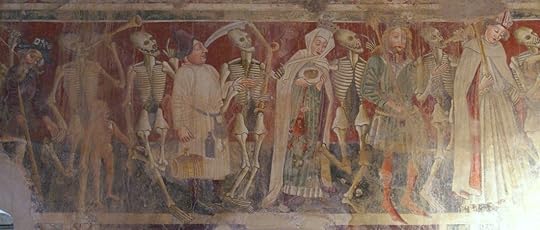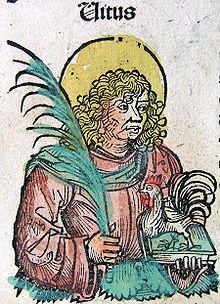Dancing With Death
 By Toffel (Own work) [GFDL (http://www.gnu.org/copyleft/fdl.html) or CC BY-SA 3.0 (http://creativecommons.org/licenses/b...)], via Wikimedia Commons When Nathan Marshal ap Tewdr, the protagonist in my new middle grade historical novel, On Fledgling Wings becomes a page for Sir Terence Newcombe, he finds that the knight is not at all what he expected. Sir Terence is paunchy, with shaggy, unkempt hair and a strange, almost staggering gait that looks as if neither foot knows where the other is headed. At dinner he fumbles with his quaking knife. He drools. He also has an irascible temper, flailing out violently when angered.
By Toffel (Own work) [GFDL (http://www.gnu.org/copyleft/fdl.html) or CC BY-SA 3.0 (http://creativecommons.org/licenses/b...)], via Wikimedia Commons When Nathan Marshal ap Tewdr, the protagonist in my new middle grade historical novel, On Fledgling Wings becomes a page for Sir Terence Newcombe, he finds that the knight is not at all what he expected. Sir Terence is paunchy, with shaggy, unkempt hair and a strange, almost staggering gait that looks as if neither foot knows where the other is headed. At dinner he fumbles with his quaking knife. He drools. He also has an irascible temper, flailing out violently when angered. Susanna the poultry woman explains that Sir Terence’s clumsiness and his temper are part of a family curse: a curse known as St. Vitus ’ Dance.
 According to Christian legend, St. Vitus was a Sicilian who died in 303, during the persecution of Emperors Diocletian and Maximian. People celebrated the feast of Vitus on June 15 by dancing before his statue. This dancing became popular, and the name "Saint Vitus Dance" became connected to any malady that involved rapid, uncoordinated jerking movements of the limbs. It also led to Vitus being considered the patron saint of dancers, actors, comedians, epileptics, and, incongruously, he is said to protect against lightning strikes.
According to Christian legend, St. Vitus was a Sicilian who died in 303, during the persecution of Emperors Diocletian and Maximian. People celebrated the feast of Vitus on June 15 by dancing before his statue. This dancing became popular, and the name "Saint Vitus Dance" became connected to any malady that involved rapid, uncoordinated jerking movements of the limbs. It also led to Vitus being considered the patron saint of dancers, actors, comedians, epileptics, and, incongruously, he is said to protect against lightning strikes. No one in the Middle Ages knew about bacteria, viruses, DNA or hereditary diseases. There were no microscopes or throat swabs or blood tests to determine what ailed a body. Therefore, diseases were diagnosed purely on symptoms. It is clear to us now that the symptoms of St. Vitus Dance were caused by not just one malady, but many. Sometimes if afflicted just one person, as it afflicts Sir Terence at Farleigh. Other times, whole towns were caught up in a frenzy of jerking, erratic, frenzied behavior.
In Sir Terence’s case, the symptoms point to a hereditary disease now known as Huntington's disease. This neurodegenerative genetic disorder affects muscle coordination and leads to mental decline and behavioral symptoms. The disease begins with subtle problems with mood or cognition. This is followed by a lack of coordination and an unsteady gait. Uncoordinated, jerky body movements and mental abilities increase, often ending in dementia. Physical symptoms can begin at any age, but usually begin between 35 and 44 years of age and develop earlier at a younger age for each successive generation, a bad sign for Terence’s son Tobias.
Another disease that was once called St. Vitus Dance is Sydenham's chorea, which is most common in children. 20-30% of children who’ve had rheumatic fever will have a bout of trembling limbs six months later. The larger outbreaks of St. Vitus Dance, those in which entire towns participated, are more difficult to diagnose. Ergot poisoning, caused by a fungus that grows on, has been blamed for hallucinations and convulsions accompanying the dance mania, but not all outbreaks of St. Vitus Dance occurred during the wet growing seasons that ergot requires. Interestingly, ergot poisoning has been blamed for the hysteria of the Salem Witch Trials as well.
Other food poisonings may have contributed to some of the outbreaks. This is certainly one theory held by the sufferers themselves, who sometimes accused Jews of poisoning their wells and drove them from town in a misguided attempt to stop the malady.
Surely a few participants were hysterics, epileptics or mentally disturbed. Other modern researches have suggested that sufferers were afflicted with a mass hysteria that was more psychological in nature. Others believe that sufferers were actually participating in some cult, and that St. Vitus Dance was more akin to a Bacchanalian ritual than a malady. Perhaps all of the above is true at different places and times. The Middle Ages were a long period of time.
 My third middle grade historical novel, On Fledgling Wings, is now available for preorder in ebook form at Amazon. If you would like to be notified when it is available in paperback, sign up for my emails.
My third middle grade historical novel, On Fledgling Wings, is now available for preorder in ebook form at Amazon. If you would like to be notified when it is available in paperback, sign up for my emails.
Published on February 27, 2015 08:49
No comments have been added yet.



